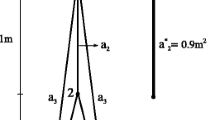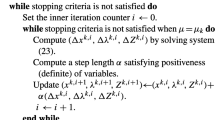Abstract
This paper investigates the use of stability and serviceability objective functions in the shape optimization of truss arch footbridges prone to in-plane snap-through buckling. The objective functions evaluated relate to global linear buckling, geometrically nonlinear response, fundamental frequency, linear compliance, and maximum deflection. These objective functions are applied to help define the global structural shape for the 2D configuration of a truss arch footbridge subjected to its governing code-defined load combination. The strength criterion of maximum axial force, the global stability responses of critical linear buckling load and nonlinear limit load, and the serviceability responses of fundamental frequency and unfactored live load deflection are used to evaluate the optimized topologies. These structural performance results are compared to those of a benchmark structure prone to in-plane snap-through buckling. The results highlight that improvement in stability and serviceability behavior can be obtained by altering the global structural form according to the presented objective functions. Stable optimized topologies, which are not prone to in-plane snap-though buckling, are achieved without the use of computationally expensive, geometrically nonlinear analysis functions.











Similar content being viewed by others
References
Achtziger W (1997) Topology optimization of discrete structures: an introduction in view of computational and nonsmooth aspects. In: Rozvany GIN (ed) Topology optimization in structural mechanics. Springer, New York, pp 57–100
Achtziger W (2007) On simultaneous optimization of truss geometry and topology. Struct Multidiscip Optim 33:285–304
Achtziger W, Kočvara M (2006) Structural Topology Optimization with Eigenvalues. Research Report No. 315, Institute of Applied Mathematics, University of Dortmund, 1–36
Alamatian J (2013) Displacement-based methods for calculating the buckling load and tracing the post-buckling regions with Dynamic Relaxation method. Comput Struct 114–115:84–97
American Association of State Highway and Transportation Officials (AASHTO) (2009) LRFD guide specifications for the design of pedestrian bridges, 2nd edn. AASHTO, Washington
American Association of State Highway and Transportation Officials (AASHTO) (2013) 2013 interim revisions to the AASHTO LRFD bridge design specifications, 6th edn. AASHTO, Washington
Austin WJ (1971) In-plane bending and buckling of arches. J Struct Div 97(5):1575–1592
Bathe K-J, Wilson EL (1973) Solution methods for eigenvalue problems in structural mechanics. Int J Numer Methods Eng 6:213–226
Bendsøe MP, Sigmund O (2003) Topology optimization: theory, methods, and applications, 2nd edn. Springer, New York
Bendsøe MP, Ben-Tal A, Zowe J (1994) Optimization methods for truss geometry and topology design. Struct Optim 7:141–159
Crisfield MA (1990) A consistent Co-rotational formulation for Non-linear, three-dimensional, beam-elements. Comput Methods Appl Mech Eng 81:131–150
Dhingra AK, Lee BH (1994) A Genetic Algorithm Approach to Single and Multiobjective Structural Optimization with Discrete-Continuous Variables. Int J Numer Methods Eng 37:4059–4080
Fauche E, Adriaenssens S, Prevost JH (2010) Structural optimization of a thin-shell bridge structure. J Int Assoc Shell Spat Struct 51(2):153–160
Felippa CA, Haugen B (2005) A unified formulation of small-strain corotational finite elements: I. Theory. Comput Methods Appl Mech Eng 194:2285–2335
Gill PE, Murray W, Saunders MA (2008) User’s Guide for SNOPT 7.1: a Fortran Package for Large-Scale Nonlinear Programming Report NA 05–2. Department of Mathematics, University of California, San Diego, La Jolla, CA
Guest JK, Prévost JH, Belytschko T (2004) Achieving minimum length scale in topology optimization using nodal design variables and projection functions. Int J Numer Methods Eng 61:238–254
Halpern AB, Adriaenssens S (2013). Coupled Form-Finding and Buckling Optimization for Stability-Sensitive Structures. In: Proc Int Assoc Shell Spat Struct Symp, IASS, Wroclaw, Poland
Hjelmstad KD, Pezeshk S (1988) Approximate analysis of post-limit response of frames. J Struct Eng 114(2):314–331
Hjelmstad KD, Pezeshk S (1991a) Optimal design of frames to resist buckling under multiple load cases. J Struct Eng 117(3):914–935
Hjelmstad KD, Pezeshk S (1991b) Optimal design of planar frames based on stability criterion. J Struct Eng 117(3):896–913
Hughes TJR (2000) The Finite Element Method: Linear Static and Dynamic Finite Element Analysis. Dover Civil and Mechnical Engineering, New York
Lindgaard E, Dahl J (2013) On compliance and buckling objective functions in topology optimization of snap-through problems. Struct Multidiscip Optim 47:409–421
Mang HA, Schranz C, Mackenzie-Helnwein P (2006) Conversion from imperfection-sensitive into imperfection-insensitive elastic structures I: theory. Comput Methods Appl Mech Eng 195:1422–1457
Pedersen NL, Nielsen AK (2003) Optimization of practical truses with constraints on eigenfrequencies, displacements, stresses, and buckling. Struct Multidiscip Optim 25:436–445
Pezeshk S (1989) Optimal design of nonlinear frames structures under multiple loading conditions based on a stability criterion. Dissertation, University of Illinois at Urbana-Champaign
Rahmatalla S, Swan CC (2003a) Form finding of sparse structures with continuum topology optimization. J Struct Eng 129(12):1707–1716
Rahmatalla S, Swan CC (2003b) Continuum Topology Optimization of Buckling-Sensitive Structures. J AIAA 46(6):1180–1189
Renton JD (1973) Buckling of long, regular trusses. Int J Solids Struct 9:1489–1500
Rezaiee-Pajand M, Alamatian J (2011) Automatic DR structural analysis of snap-through and snap-back using optimized load increments. J Struct Eng 137(1):109–116
Schlaich M et al (2005) Guidelines for the design of footbridges. International federation for structural concrete. Lausanne, Switzerland
Service d’Études techniques des routes et autoroutes (Sétra) (2006) Technical Guide Footbridges: Assessment of vibrational behaviour footbridges under pedestrian loading. Association Française de Génie Civil, Paris
U.S. Department of Transportation (USDOT) (2010) ADA Standards for Transportation Facilities. Federal Transit Administration, Washington, D.C
Van Nimmen K, Lombaert G, De Roeck G, Van den Broeck P (2014) Vibration serviceability of footbridges: evaluation of the current codes of practice. Eng Struct 59:448–461
Wang D (2004) Optimization of support positions to minimize the maximal deflection of structures. Int J Solids Struct 41:7445–7458
Zhou K (2013) Topology optimization of truss-like continuum structures for natural frequencies. Struct Multidiscip Optim 47:613–619
Acknowledgments
This work was supported by the Sherrerd Fellowship in Civil and Environmental Engineering of Princeton University, which is made possible through a donation by the Sherrerd Foundation. The authors would like to extend their gratitude to Professor Philip E. Gill (University of California, San Diego) and Professor Michael A. Saunders (Stanford University) for use of the SNOPT software. The authors would like to thank Professor Jean H. Prévost (Princeton University), Ted Zoli (HNTB Corporation), and Serguei Bagrianski (Princeton University) for their constructive feedback and advice. The authors would also like to thank the reviewers for their exceptionally valuable comments and helpful suggestions.
Author information
Authors and Affiliations
Corresponding author
Rights and permissions
About this article
Cite this article
Halpern, A.B., Adriaenssens, S. In-plane optimization of truss arch footbridges using stability and serviceability objective functions. Struct Multidisc Optim 51, 971–985 (2015). https://doi.org/10.1007/s00158-014-1187-7
Received:
Revised:
Accepted:
Published:
Issue Date:
DOI: https://doi.org/10.1007/s00158-014-1187-7




